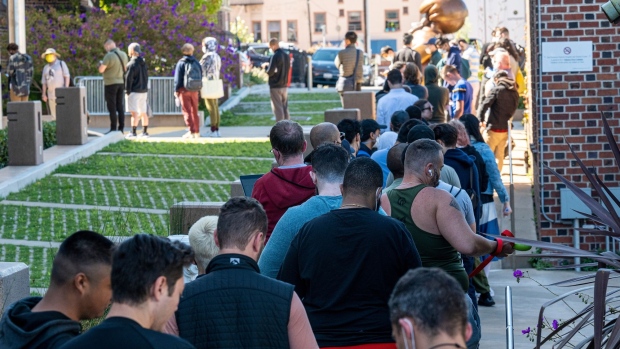Aug 12, 2022
Cutting Monkeypox Vaccine Dosage Is No Easy Fix, Officials Say
, Bloomberg News

(Bloomberg) -- The US government’s solution to the monkeypox vaccine shortage is so far only causing headaches for strained public health departments as the outbreak continues to grow in scale and scope.
The so-called dose-sparing strategy allows those giving out the vaccine to use just one-fifth of what’s traditionally given in attempt to squeeze more doses out of the existing supply. While sounding good in theory, the move requires “a significant shift in operations” for local health departments, Allison Arwady, Chicago’s public health commissioner, said during a Big Cities Health Coalition meeting. And it could be weeks before clinicians actually start employing this strategy, she said.
The Food and Drug Administration on Tuesday approved emergency use of a different vaccination technique in order to extend the supply of Bavarian Nordic A/S’s monkeypox shot, Jynneos. Under the alternate method, injections are given between skin layers, instead of beneath them. A lower dosage means a single vial can supply five shots, instead of just one.
The US leads globally in most monkeypox cases, topping 10,700 infections as of Thursday. The outbreak so far has disproportionately affected men who have sex with men and has spread primarily through close contact. Jynneos is given to those considered at high risk of being exposed to someone with monkeypox. US health officials estimate there are nearly 1.7 million people at highest risk—but there’s currently only about 400,000 doses left in the US stockpile, which isn’t nearly enough without a strategy to extend that supply. The maker of the vaccine isn’t convinced this is the right approach though. Paul Chaplin, chief executive officer of Bavarian Nordic, expressed “reservations” about the new strategy.“Since last Thursday, we have been inundated with calls from US state government officials with questions and concerns,” Chaplin wrote in a letter Tuesday to Health and Human Services Secretary Xavier Becerra and FDA Commissioner Robert Califf. US health officials didn’t coordinate with the company prior to announcing the dose-extending strategy, he said. Now, the company is trying to quickly collect additional data on safety and efficacy while also assisting state officials in the rollout.Chaplin also said the company would have supported an alternate strategy in which second shots were delayed until more supply is available, something several state and local health departments had already been doing despite US health officials urging against it.Although injecting vaccines between skin layers is safe and used in other types of procedures such as tuberculosis tests, it’s less common than the more standard subcutaneous vaccination. The decision to switch the strategy was largely based on a 2015 clinical trial that found little difference in efficacy when Jynneos was given between skin layers and subcutaneously.
Health experts have raised concerns, however, that one small clinical trial is insufficient evidence for changing the vaccination protocol. The lack of real-world effectiveness data could also present problems. For example, the 2015 clinical trial showed that there is more redness and swelling associated with the alternate approach, something that could deter people from coming back for their second dose, according to Michael Ganio, the senior director of pharmacy practice and quality at the American Society of Health-System Pharmacists.The prospect of extending supply was initially met with relief, Chicago’s Arwady said, but reality quickly set in that it would not be that easy. Intradermal vaccination requires a special syringe and thinner needle, training for health-care workers and a different mechanism for reporting inoculation information. And so far, public health departments—often grossly under-resourced as it is—are doing it without additional financial support from the federal government.“We’ve been at this for three months with no money,” Arwady said, adding the expectation is that public health departments can roll out vaccines for monkeypox much like they did for Covid, for which there was far more federal financial support.Most health-care workers are unfamiliar with how to give shots in this new way. For example, if the vaccine is administered too deeply, the smaller dose won’t be effective, but if the shot is too shallow, vaccine fluid can leak out of the injection site, Ganio explained. The US Centers for Disease Control and Prevention has already started rolling out educational materials for clinicians and is working with local health departments on additional training resources like online videos.There are some serious safety considerations as well. Clinicians must make sure needles aren’t reused and that vials are discarded eight hours after opening.
“This population could be higher risk for HIV, hepatitis,” Arwady said. “There’s just a lot of training to make sure our procedures are good, our safety is good, that people understand how we switch to multidose vials.”
Switching to the low-dose approach after three months also raises equity concerns, some public health experts argue. In US cities hard hit by the outbreak, White people have so far gotten the majority of vaccines, data collected by Bloomberg show. For example, in Chicago, 55% of vaccines have gone to White people, who comprise just 44% of all monkeypox cases there. Across the country, minority communities are the most impacted by the outbreak, according to the CDC.
The message this sends to Black and Latino people who may not have had early access to the vaccine, is that “their health is only worth one-fifth of the White, gay men who were able to get vaccinated,” according to Nick Diamond, a public health expert and a co-investigator of the New York City-based monkeypox study RESPND-MI.
©2022 Bloomberg L.P.


